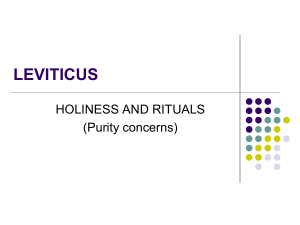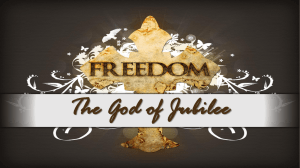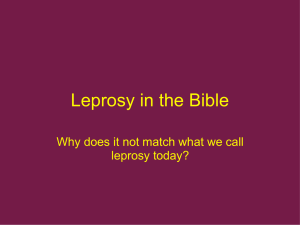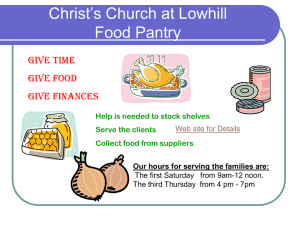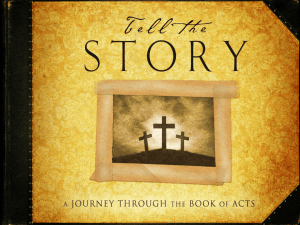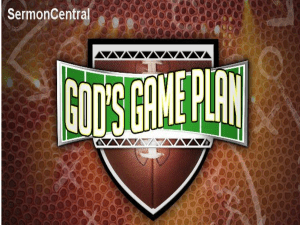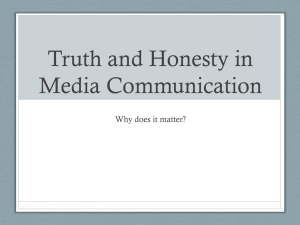B05 L3 Leviticus
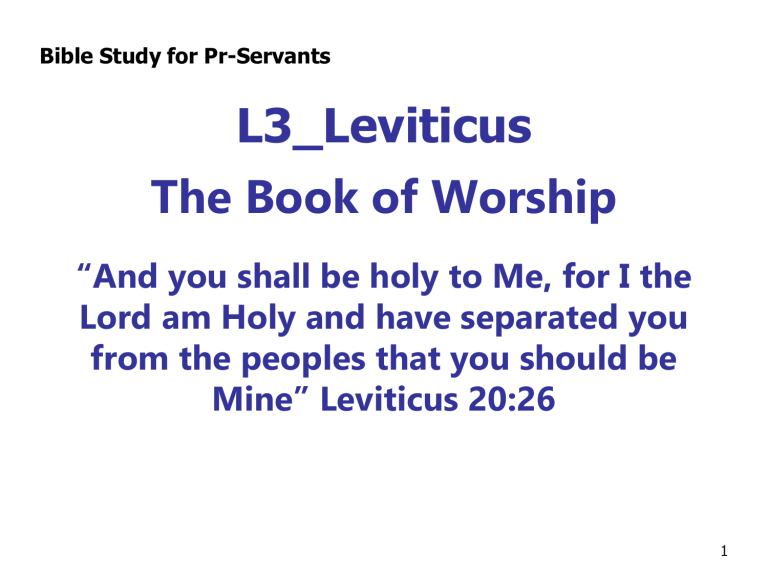
Bible Study for Pr-Servants
L3_Leviticus
The Book of Worship
“And you shall be holy to Me, for I the
Lord am Holy and have separated you from the peoples that you should be
Mine” Leviticus 20:26
1
The Law – Torah
The Pentateuch
Genesis
Exodus
Leviticus
Numbers
Deuteronomy
2
Genesis
Begins with creation
Depicts the rise of God’s people
Origins of the nation
Theocracy born
Exodus Leviticus
Begins in bondage
Begins in sacrifice
Tells of the redemption from Egypt
Sets forth the rituals of worship and holiness
Deliverance of the nation
Life of the nation
Theocracy established
Contrast of Exodus & Leviticus
Exodus ended with the worship
who
and
where
of
who = Yahweh
where = Tabernacle
Leviticus throughout deals with
why
of worship
how
and
how = Sacrifices & Priesthood
why = Holiness
Leviticus: Introduction
Title:
Israel.
Leviticus – derived from the tribe of Levi, the priests of
Historical Setting: Leviticus comprises the 30 days following the establishment of the tabernacle at Mount Sinai
Themes:
1. Right Worship Inside the Tabernacle
Laws concerning sacrifice and public worship (ch. 1-10)
Laws of holiness (ch. 11-15)
2. Right Living Outside the Tabernacle
Cleansing of the sanctuary/related regulations (ch. 16-17)
Civil and behavioral laws (ch. 18-20)
Laws pertaining to feast days, festivals, and other sanctuary regulations (ch. 21-27)
General Theme: God is holy; man is sinful; and God graciously forgives man’s sin because a blameless animal— which illustrated Christ dying for the sins of the world—died in man’s place.
5
Leviticus: Background to events?
The Angelic Conflict in which Satan attempts to take God’s authority.
God’s Redemption Plan through the seed of Eve to
Abraham, Isaac, and Jacob.
God made his unconditional covenant with Abraham to make him into a great nation and to bless the world through Abraham’s seed—specifically Jesus Christ.
God formed the Hebrews into a nation in Egypt and later at Sinai God made them his priest nation.
God’s redemption plan, through Israel, was on schedule, even though Satan repeatedly tried to stop God’s plan.
6
Leviticus: Narrative
God revealed his instructions for the priestly ministry to
Moses. God instructed about the offerings and sacrifices, the dedication and service of the priests, and regulations and warnings about how Israel was to live.
Nadab and Abihu, sons of Aaron ignored God’s instructions for their priestly service and instead did it their way. They suffered ultimate discipline, the sin unto death.
The regulations included the laws for clean and unclean, holy living, annual festivals, national blessing or discipline, and free will dedications.
7
Leviticus: Narrative “Cont’d”
God revealed his instructions for the priestly ministry to
Moses. God instructed about the offerings and sacrifices, the dedication and service of the priests, and regulations and warnings about how Israel was to live.
Nadab and Abihu, sons of Aaron ignored God’s instructions for their priestly service and instead did it their way. They suffered ultimate discipline, the sin unto death.
The regulations included the laws for clean and unclean, holy living, annual festivals, national blessing or discipline, and free will dedications.
8
Leviticus: Key Words Used
Atonement, 55 times
Holy, 90 times
Priest, 191 times
Offering, 331 times
Sacrifice, 44 times
Sin, 82 times
Leviticus: Main People
Moses
Aaron
9
Jewish Calendar
South
Leviticus: Tabernacle
West
North
East
11
The Tabernacle
God “tabernacled” with Israel
Levites camped in inner circle
East: Judah, Issachar, and Zebulun (Leah’s children)
South: Reuben, Simeon (Leah’s children), and Gad
(Zilpah-L)
West: Ephraim, Manasseh, and Benjamin (Rachel’s children)
North: Dan (Bilhah-R); Asher (Zilpah-L), Naphtali (Bilhah-R)
Tent in wilderness period (inside or outside camp)
Tent, or building, at Shiloh (Eli and Samuel)
Tent of David
Temple of Solomon
Leviticus Overview
1. Five Sacrifices (1-7)
2. Priestly Mediators (8-10)
3. Clean and Unclean (11-15)
4. Day of Atonement (16)
5. Holy Living (17-25)
6. Blessing or Cycles of Discipline (26)
7. Free Will Offerings of Dedication (27)
13
Leviticus Chapter Titles:
Five Sacrifices, 1-7
Chapter 1: Burnt Offering
Chapter 2: Grain Offering
Chapter 3: Peace Offering
Chapter 4: Sin Offering
Chapter 5: Guilt Offerings
Chapter 6: More on Sin and Trespass Offerings
Chapter 7: More on Sin and Trespass Offerings
14
Leviticus 1-7: Offerings
Burnt (Voluntary)—Reconciliation
Grain (Voluntary)—Positional Relationship with
God
Peace (Voluntary)—Fellowship with God
Sin (Required)—Confession of Sin
Guilt (Required)—Confession of Sin
15
Types of Sacrifices
Sin offering. Got rid of contamination to sanctuary caused by transgressions
Burnt offering. Expressed worshipers deepest thanksgiving and dedication.
Peace offering. A meal shared by worshipping family.
Sacrifice of Christ on the cross expresses all three of these functions.
Leviticus Chapter 8-10:
Priestly Mediators
Chapter 8: Dedication of the Priests
Chapter 9: First Priestly Service
Chapter 10: Nadab and Abihu
17
Leviticus 11-15: Clean and Unclean
Why the regulations? The priests were to teach the people to distinguish between holy and profane, clean and unclean (Lev 10.10-11; 11.47). To do this God revealed divine viewpoint about dietary laws (Lev 11), disease (Lev 13-14), and other physical uncleanness (Lev
12,15) e.g. skin diseases (psoriasis or fungal) chaps 13-
14, women at childbirth 12:1-5, etc.
The laws for uncleanness and purification served to highlight 1) God’s holiness, 2) man’s sin, 3) the distinction between relationship with Yahweh (LORD) their God and religion around them, and 4) to point out
Israel’s priest nation status. An unclean person was prohibited from participating in the tabernacle services.
18
Leviticus Chapter 16
Day of Atonement
Chapter 16: Day of Atonement
Only time of year when High Priest allowed in
Holy of Holies
High Priest offered bull as a sin offering for himself and his household
Blood from goat--purged sanctuary of defilement from transgressions; altar atoned for with blood from bull and goat
Goat for Azazel--sins of people carried away
19
Leviticus Chapter 17-27:Holy Living
Chapter 17: Blood, Life, Death
Chapter 18: Sexual Sin and Perversion
Chapter 19: Regulations for Life – Be Holy
Chapter 20: Death Penalty Sins for God’s Separated People
Chapter 21: Regulations for Priests – Defilement
Chapter 22: Regulations for Priests – Offerings
Chapter 23: Annual Feasts
Chapter 24: The Holy Place, Blasphemy, and Justice
Chapter 25: Sabbath and Jubilee Years
Chapter 26: Blessings or Cycles of Discipline
Chapter 27: Free Will Offerings of Dedication
20
Leviticus 23: Feasts
Passover—Redemption
Unleavened Bread—Separation from past to new life with God
Firstfruits—Thanksgiving and God provides
Pentecost—Thanksgiving and God Provides over and above
Trumpets—Called the Lord’s attention to Israel’s need of his blessing
Day of Atonement—God graciously forgives sin
Booths—God gives fatherly care and protection
21
Leviticus Chapter 25
Sabbatical year; Jubilee year
Sabbatical or Seventh year
Jubilee after seven sabbatical years
“Proclaim liberty throughout the land”
Land returned to family which originally owned it
Yahweh alone owns land; we are resident aliens slaves freed no record of historical observance, but...
Leviticus 26: Cycles of
National Discipline
First—mental and physical illness, economic downturns, military losses (26.14-17)
Second—loss of influence, drought, famine, economic failure (26.18-20)
Third—domestic terror, culture and society breakdown,
(26.21-22)
Fourth—disease, military invasion, national vassalage, famine (26.23-26)
Fifth—culture and social disintegration, religious anarchy, national destruction and exile (26.27-39)
23
Lessons for us from Leviticus
God is holy and man’s sin separates him from God.
The sin must be removed by a blameless sacrifice. Levitical sacrifices pictured Christ’s future sacrifice for mankind’s sin.
The sacrifice of Christ also paid for believers’ sins. We confess a sin when we commit it. Confession is a recognition that Christ died for that sin.
God has given each believer a ministry. We should do it for him and with thankfulness.
24
Christ in Leviticus
A) The Five offerings
The burnt offering => Christ’s total offering in submission to His Father’s will.
The grain (meal) offering => Christ’s sinless service.
The peace offering => the fellowship that believers have with God through the work of the Cross.
The sin offering => Christ as our sin-bearer.
The guilt (trespass) offering => Christ’s payment for the damage of sin.
25
Christ in Leviticus
B) The High Priest
Aaron is the first high priest. Christ is our eternal High Priest.
Aaron was a human being. Christ, our High Priest, is God.
Aaron's priesthood was an earthly one and operated in connection with an earthly sanctuary. Christ's priesthood is a heavenly one, Hebrews 8:1.
Aaron and his sons offered physical, animal sacrifices, which could never take away sins, Hebrews 10:11. Christ, on the other hand, offered Himself through the eternal Spirit without spot to God. The blood of animals could never atone for sin, but the precious blood of Christ indeed purges the conscience from dead works to serve the living God, Hebrews 9:14.
Aaron and his sons did what all men do eventuallythey died , Heb. 7:23.
Christ- continues forever (eternal); He has an unchangeable priesthood
Hebrews 7:24, and so He is able to save to the very end, Hebrews 7:25.
Aaron had to offer sacrifices not only for the sins of the people, but also for his own sins, Hebrews 5:3. Christ died for our sins because He is sinless .
26
Christ in Leviticus
C) The Seven Feasts
Passover => the substitutionary death of the Lamb of God. Christ died on the day of Passover.
Unleavened Bread => the holy walk of the believer (1 Cor. 5:6–8).
First fruits => Christ’s resurrection as the first fruit of the resurrection of all believers (1 Cor. 15:20–23). Christ rose on the day of the First fruits.
Pentecost =>the descent of the Holy Spirit after Christ’s ascension.
Trumpets, the Day of Atonement, and
Tabernacles =>events associated with the second advent of Christ.
This may be why these three are separated by a long gap from the first four in Israel’s annual cycle.
27
